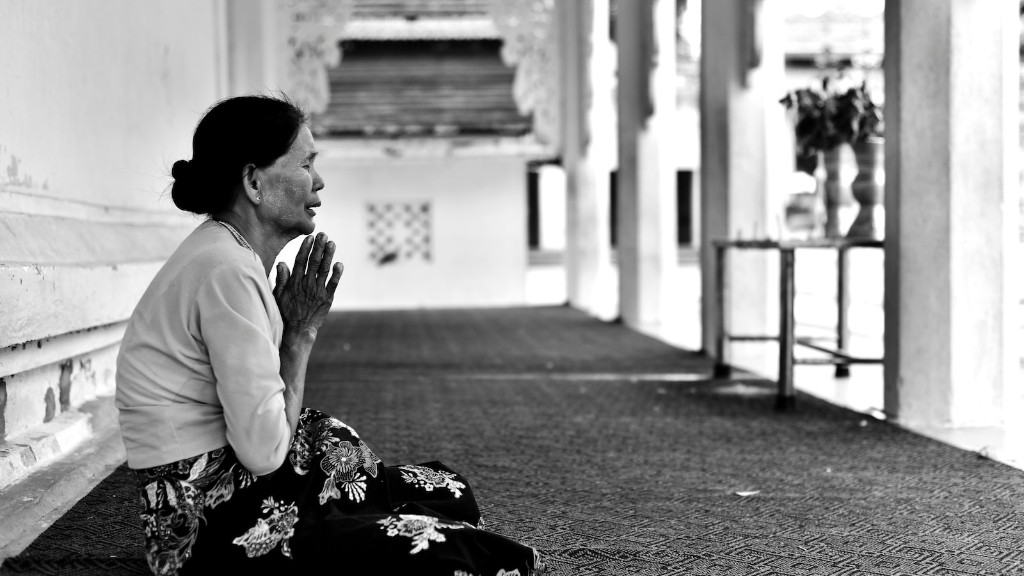Hasidic Judaism is a branch of Orthodox Judaism which originated in the 18th century in what is now Ukraine and Poland. It emphasizes emotion and joy in religious practice and spiritual life and is traditionally practiced by the Hasidic Jewish community. Hasidic Jews commonly wear traditional clothing, such as the streimel and school, though not all are recognizable by their clothing.
The philosophy of Hasidic Judaism teaches that everyone has the ability to experience a personal connection with God and the soul is inherently pure. Hasidic teachings focus on activating the inner soul with prayer, study and service to others. The Hasidic movement has developed an extensive theology, moral code and spirituality that followers must adhere to.
At the core of Hasidic Judaism is the belief that by emerging into ecstatic union with God, individuals can achieve great spiritual reward. Believers seek to find the presence of God in their everyday life, directing even mundane activities to higher spiritual purpose. Hasidim, or followers of Hasidic Judaism, believe that joy and enthusiasm should be displayed when fulfilling mitzvot, or religious commandments. Along with believing in God and Heaven, followers of Hasidic Judaism also follow a strict adherence to traditional Jewish law as found in the Torah and Talmud, as well as lashon ha’ra, a Hebrew term for speaking of others in a good light.
This type of Judaism differs from others in many ways. The rabbis, or leaders, are chosen on the basis of their piety and their understanding of the spiritual. Most people in the community disapprove of practices which are deemed as not in line with rigidly-preserved religious customs and beliefs. As a result, they view the secular world with suspicion, and many guard themselves against what they perceive as outside influences.
The Hasidic communities are considered relatively insular, as members of the community strive to maintain their traditions. The focus of this form of Judaism is on reinvigorating everyday rituals and helping individuals attain a relationship with God. One of the most fundamental qualifications for entering into the Hasidic Jewish world is the ability to speak Yiddish and to wear traditional clothing.
For the Hasidic Jews, spiritual devotion to God can be accomplished through the everyday experiences of life, such as a prayer, a kind deed, or even a warm smile. Hasidic Jews strive to make Judaism relevant to their lives in a manner that is meaningful and spiritually rewarding. They also strive to develop an emotional, passionate connection with God.
Synagogue Services
Synagogue services are the cornerstone of Hasidic Judaism and provide the primary means for connecting to God. Services begin each day with the morning prayer, or Shacharit, and end with the evening prayer, Maariv. Throughout the day, additional prayers such as the Mincha and Maariv are said. Prayer services are done with great care and devotion, and can last several hours. The service also includes chanting of various Psalms and studying of the Torah.
The Hasidic synagogue service incorporates music and dancing, which is believed to be a form of “Divine joy” that connects participants to God. Hasidic Jews believe that by allowing themselves to move and feel joyful during prayer, they are opening themselves up to the Divine experience of rejoicing in God’s presence. This is further emphasized in prayers such as the Kabbalat Shabbat, where prayers are interspersed with traditional Hasidic music, sung with great emotion.
Services also serve to reinforce the social values and practices of the community. They provide an opportunity for community members to come together in prayer, study and conversation, while embodying the characteristics of joy, love and dedication to God that Hasidic Jews strive to embody in their daily lives.
Relationship to Torah
The desire of Hasidic Jews to live a religious Jewish life that is meaningful and joyous is grounded in the teachings of the Torah and Jewish law, known as Halakha. The ancient rabbis laid out a code of Ethics of the Fathers, which is based on the Torah’s commandments, and this code is still followed today by Hasidic Jews. This code teaches that a person should strive to always do what is right, to treat people with respect and fairness, and to love everyone as if they were family.
The Hasidic approach to Torah study is based on the teachings of the Kabbalah. This mystical branch of Jewish teaching is often passed down orally through masters, or rebbes, in order to ensure that it is not lost. Because of this, much of the Hasidic interpretation of Torah is unique and not found in any other approach to Torah study. The teaching of Kabbalah emphasizes joy, enthusiasm, and a personal connection with God, which are all integral components of Hasidic Judaism.
The central importance of the Torah can be seen in the value placed on its study and its place in the daily life of observant Hasidic Jews. The holy words of the Torah are studied and cherished, and its teachings are incorporated into the daily practice and values of the community.
Modern Expression in Hasidic Communities
Hasidic Judaism is the support, spiritual foundation, and the heart of modern observant Jewish life. Through their dedication to the study of Torah, adherence to Jewish law, and commitment to a life of joyous service to God, Hasidic Jews have reaffirmed the centrality of God, prayer, and synagogue in Jewish life.
Modern Hasidic communities have grown and flourished and now there are countless centers around the world. Although the specifics of their religious practices may vary, all Hasidic Jews share a common bond of devotion to God and a dedication to spiritual life. Hasidic Jews are a vibrant and integral part of the Jewish community, and their distinctive clothing and customs can be seen in many places around the world.
Today, Hasidic Jews are respected as a model of piety and devotion to Jewish law and tradition. They provide an example of true spirituality and religious practice that is rooted in the teachings of the Torah and inspired by the grandeur and beauty of God.
Hasidism’s Influence on Jewish Life
In the centuries since Hasidic Judaism rose to prominence, it has had a profound impact on Jewish life and practice. Hasidic communities have become a fundamental part of the Jewish experience, providing a living example of traditional Jewish devotion and spirituality. The Hasidic emphasis on joy, enthusiasm, and a personal connection with God has been embraced by many Jews, and is seen in the way modern Jews practice their faith.
Hasidic teachings on prayer, study, and service to God have shaped the modern Jewish religious experience. Hasidic Jews honor the life of the righteous and emphasize the importance of joy and enthusiasm when following commandments. They believe in the possibility of tova’at M’nucha, or “Divine service with joy,” and strive to serve God out of love and happiness, rather than out of obligation.
The influence of Hasidic Judaism can also be seen in the emphasis that many modern Jews place on connecting to God, emphasizing joy in religious life, and living a mindful moral and ethical life. Hasidic Jews today strive to live a fully observant and meaningful religious life, and their impact is seen in the wider Jewish world.
Gender Roles in Hasidic Judaism
Within Hasidic culture, the gender roles of men and women are clearly defined. Men are responsible for praying and studying Torah, and for making the decisions necessary for running a Jewish household. Women are expected to be responsible for managing the home, raising the children, and creating a welcoming and pious home environment. In many Hasidic communities, women are discouraged from taking on any role outside of their traditional domestic responsibilities.
The male role in Hasidic Judaism is also heavily centered around religious responsibilities. Men are the leaders of prayer and study, and they are expected to serve as mentors and spiritual advisors to those seeking guidance and knowledge. Men are also typically responsible for earning a living for the family and leading other aspects of communal life, such as ritual services.
Hasidic women have historically been expected to focus their energies on the home, children, and family. Women are responsible for the creation of a spiritual and pious atmosphere in the home and are expected to be the moral and religious role models for the young children. Although women follow the same religious laws and traditions as men, they are often not allowed to lead prayers, study Torah publicly, or take on any official roles in leadership.
Cultural Practices
Hasidic Judaism has many unique customs and practices, many of which are rooted in religious observance. These rituals are practiced in order to maintain the hallmarks of Hasidic Judaism, such as joy, spirituality, and dedication to God.
Many Hasidic Jews observe strict dietary laws, or Kashrut, as dictated by Jewish law. This includes avoidance of certain animal products, as well as a strict abstinence from all food and drink during certain days of the week.
Another important practice among Hasidic Jews is the Sabbath. Sabbath observance is an important part of Hasidic life, and families typically avoid all forms of work during the day. Special meal preparations for the Sabbath are often made in advance, and prayers and studies are held in the synagogue. Hasidic Jews also observe certain customs such as the lighting of candles at sundown and the abstention from electronic media such as television and radio.
Many Hasidic Jews also believe in the power of prayer and use it as a form of spiritual protection, blessing or comfort. Traditional prayers focus on the protection and well-being of family and community, as well as joy and contentment. Hasidic Jews also place great emphasis on charity, or Tzedakah, and view it as a way to demonstrate their commitment to God and to humanity.



